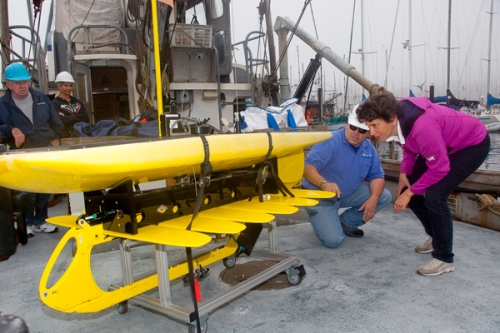By Kalwinder KaurAug 27 2012
Stanford marine biologists recently identified a white shark along the California coast north of San Francisco, marking the first step of advancement in "wired ocean". This project gives real-time information of sharks and other animals, and also introduces a new iPhone and iPad app to better connect to ocean and marine creatures.
 A 3-D model of Tom Johnson, one of the seven white sharks featured in the Shark Net app
A 3-D model of Tom Johnson, one of the seven white sharks featured in the Shark Net app
Named Carey, after a fish biologist, the Wave Glider robot is investigating the Pacific Ocean beyond the California coast. The research involving marine predators has been led by Stanford marine sciences Professor Barbara Block and her research team.
Inspired by the 10-year long Tagging of Pacific Predators (TOPP) project focused on great white sharks, this Blue Serengeti Initiative has been carried out.
Block and her colleagues found North America's West Coast to contain several varied creatures like tuna, white sharks, sea turtles, seals, and albatross. Therefore, the California Current is likened toAfrica's Serengeti.
This initiative also involves wiring up the favorable regions discovered during TOPP. As part of the initiative, a cost-effective technology has to be adopted for long-term tracking of sharks, and bringing listening stations to the water.
At present, acoustic tags have been equipped to 120 white sharks along with five mako sharks and 27 salmon sharks, in addition to other creatures. Those buoys are moored in Tomales Point, Año Nuevo, and the Farallon Islands, which are three foraging hot spots that are populated with seals, sea lions, and other prey attracting white sharks. A shark's transmitter or any animal having an acoustic tag can be detected by the buoys beyond 2,000 ft. The data is rapidly transmitted in near real time to mobile devices.
The unmanned Carey "surfs" up and down the coast, near the hot spots. Liquid Robotics-made device features an underwater glider linked to a 7-foot-long "surfboard" having scientific equipment glides on the surface. The glider is vertically pulled in accordance to the floating of waves. The glider's fins rotate, converting an upward wave motion to forward thrust and in the opposite direction. Based on this cyclical, nonstop action, the glider pulls the float along a route set by the scientists.
Carey carries sensory gear. The link is powered to a satellite via solar panels on the floating board. Sensing of rainbow trout eventually led to picking king salmon and several sharks.
The new project highlights acoustic detection data fed into an iPhone and iPad app. Shark Net, being offered in iTunes Store, enables users to track the behavior of about 20 white sharks.
Disclaimer: The views expressed here are those of the author expressed in their private capacity and do not necessarily represent the views of AZoM.com Limited T/A AZoNetwork the owner and operator of this website. This disclaimer forms part of the Terms and conditions of use of this website.